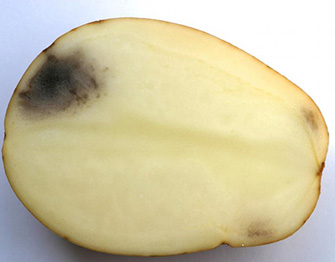Please click here to access the main AHDB website and other sectors.
- Home
- Knowledge library
- Bruise and damage
Bruise and damage
Bruising occurs when potato tubers are impacted. The skin doesn’t break, but internal tissues are damaged causing black or dark to light grey patches which are referred to as blackspot bruising

It has been difficult to develop a measure for bruise and damage potential within a crop, due to the many factors involved in bruise and damage susceptibility and the interaction between these factors.
Identification
Blackspot bruising can be anywhere on the tuber, but is more prevalent at the stolon end, and where the tuber is more curved.
Damage can be divided into internal fissures and crushing when the skin is intact, which can be difficult to see. Splitting and cracking occurs when the skin breaks and internal tissues are visible.
If the tuber is dry, this can sometimes be highlighted by a wet line on the tuber and any adhering soil looking wet.
Scuffing occurs when the skin is removed and internal tissues are visible. This is more of a rubbing action rather than an impact.
Control
The factors that will influence bruise and damage susceptibility include variety, site selection, soil type, field layout, soil preparation, planting, crop Nutrition, irrigation, crop maturity, dry matter, tuber turgor, haulm destruction, soil moisture at burn off, soil moisture at harvest, temperature, storage and machinery set up and maintenance.
The season will affect many of these and be out of a growers’ control, but a reduction in susceptibility may be seen with attention to detail and thinking about bruise and damage during potato operations. The harvester set up is a key element, but there is always the trade off between stopping to adjust the harvester, and lifting pressures. The key point is to reduce drop heights as tubers move from one belt or web to another, and to stop knocks between tubers as they move on the belt. This is achieved by running belts full of tubers, or on a harvester using soil.

